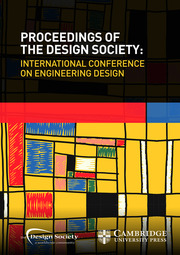Article contents
Goal Oriented Provision of Design Principles for Additive Manufacturing to Support Conceptual Design
Published online by Cambridge University Press: 26 July 2019
Abstract
Additive Manufacturing (AM) offers a new degree in design freedom. However, in order to exploit AM's potentials in end-use products a methodical approach and suitable tools especially during conceptual design are needed. This paper presents a methodology for application in industrial practice, which should support the component conception for additively manufactured products. The approach focuses on a benefit-oriented preparation and provision of knowledge. In addition to general design methods for abstraction and promotion of creativity, AM-specific tools are introduced which support the provision of solution principles and process-specific restrictions. A broad applicability of the solution principles is ensured by an expansion of the solution space through abstraction. Consequently, product developers are sensitised to the new design possibilities of AM, on the one hand. On the other hand, they are supported in a holistic exploitation of design potentials in ideation in order to foster innovative solution ideas. Finally, the methodological procedure and the developed tools will be demonstrated in a workshop by using an example from industrial practice of the automotive sector.
- Type
- Article
- Information
- Proceedings of the Design Society: International Conference on Engineering Design , Volume 1 , Issue 1 , July 2019 , pp. 749 - 758
- Creative Commons
- This is an Open Access article, distributed under the terms of the Creative Commons Attribution-NonCommercial-NoDerivatives licence (http://creativecommons.org/licenses/by-nc-nd/4.0/), which permits non-commercial re-use, distribution, and reproduction in any medium, provided the original work is unaltered and is properly cited. The written permission of Cambridge University Press must be obtained for commercial re-use or in order to create a derivative work.
- Copyright
- © The Author(s) 2019
References
- 13
- Cited by


